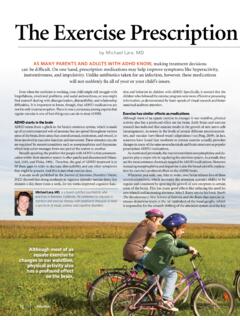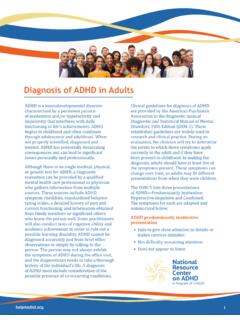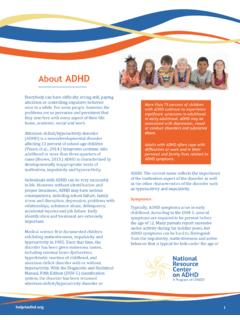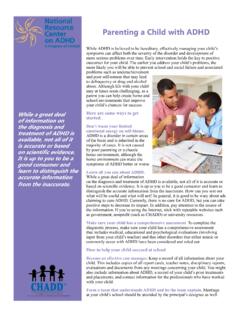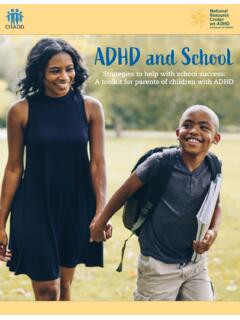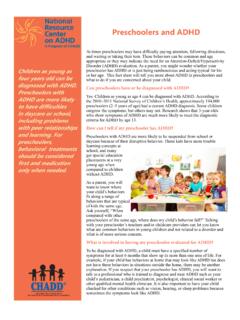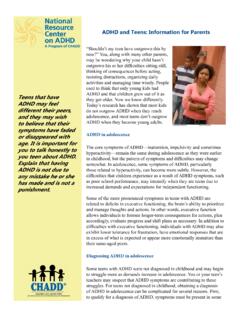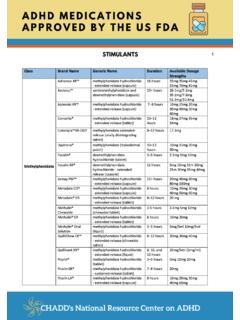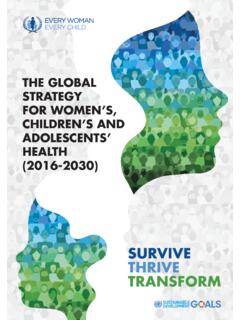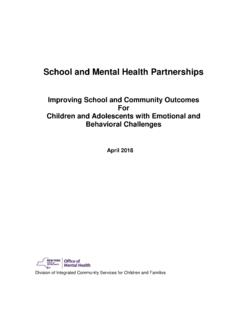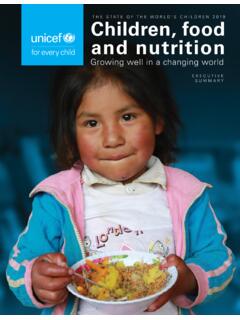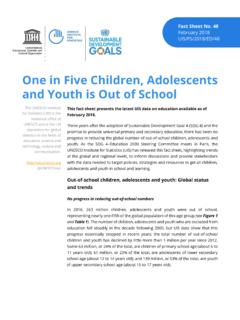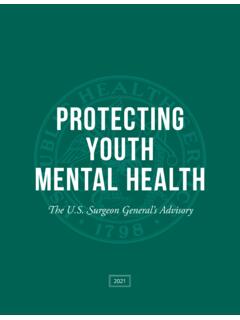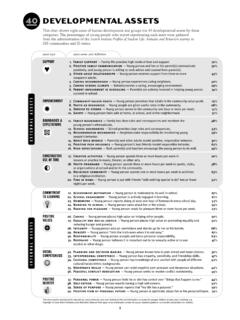Transcription of Psychosocial Treatment for Children & Adolescents with …
1 Treatment is a critical part of Treatment for attention-deficit/ hyperactivity disorder (ADHD) in Children and Adolescents . The scientific literature, the National Institute of Mental Health and many professional organizations agree that behaviorally oriented Psychosocial treatments also called behavior therapy or behavior modification and stimulant medication have a solid base of scientific evidence demonstrating their effectiveness. Behavior modification is the only nonmedical Treatment for ADHD with a large scientific evidence ADHD in Children often involves medical, educational and behavioral interventions. This comprehensive approach to Treatment is called multimodal and consists of parent and child education about diagnosis and Treatment , behavior management techniques, medication, and school programming and supports. The severity an d type of ADHD may be factors in deciding which components are necessary.
2 Treatment should be tailored to the unique needs of each child and use Psychosocial treatments?Behavioral Treatment for ADHD is important for several reasons. First, Children with ADHD face problems in daily life that go well beyond their symptoms of inattentiveness, hyperactivity and impulsivity, including poor academic performance and behavior at school, poor relationships with peers and siblings, failure to obey adult requests and poor relationships with their parents. These problems are extremely important because NationalResourceCenteron ADHDA Program of CHADD they predict how Children with ADHD will do in the long has shown that how a child with ADHD will do in adulthood is best predicted by three things: (1) whether his or her parents use effective parenting skills, (2) how he or she gets along with other Children and (3) his or her success in school. Psychosocial treatments are effective in treating these important domains.
3 In addition, behavioral treatments teach skills to parents and teachers that help them deal with Children with ADHD. They also teach skills to Children with ADHD that will help them overcome their impairments. Learning these skills is especially important because ADHD is a chronic condition and these skills will be useful throughout the Children s treatments for ADHD should be started as soon as the child receives a diagnosis. There are behavioral interventions that work well for preschoolers, elementary-age students, and teenagers with ADHD, and there is consensus that starting early is better than starting later. Parents, schools and practitioners should not put off beginning effective behavioral treatments for Children with Treatment for Children & Adolescents with is behavior modification?With behavior modification, parents, teachers and Children learn specific techniques and skills from a therapist, or an educator experienced in the approach, that will help i mprove Children s behavior.
4 Parents and teachers then use the skills in their daily interactions with their Children with ADHD, resulting in improvement in the Children s functioning in the key areas noted above. In addition, the Children with ADHD use the skills they learn in their interactions with other modification is often put in terms of ABCs: Antecedents (things that set off or happen before behaviors), Behaviors (things the child does that parents and teachers want to change), and Consequences (things that happen after behaviors). In behavioral programs, adults learn to change antecedents (for example, how they give commands to Children ) and consequences (for example, how they react when a child obeys or disobeys a command) in order to change the child s behavior (that is, the child s response to the command). By consistently changing the ways that they respond to Children s behaviors, adults teach the Children new ways of behaving.
5 Following behavior. 4. Implement behavioral interventions over the long haul not just for a few Teaching and learning new skills take time, and Children s improvement will be who want to try a behavioral approach with their Children should learn what distinguishes behavior modification from other approaches so they can recognize effective behavioral Treatment and be confident that what the therapist is offering will improve their child s functioning. Many psychotherapeutic treatments have not been proven to work for Children with ADHD. Traditional individual therapy, in which a child spends time with a therapist or school counselor talking about his or her problems or playing with dolls or toys, is not behavior modification. Such talk or play therapies do not teach skills and have not been shown to work for Children with does a behavior modification program begin?
6 The first step is identifying a mental health professional who can provide behavioral therapy. Finding the right professional may be difficult for some families, especially for those that are economically disadvantaged or socially or geographically isolated. Families should ask their primary care physicians for a referral or contact their insurance company for a list of providers who participate in the insurance plan, though health insurance may not cover the costs of the kind of intensive Treatment that is most helpful. Other sources of referrals include professional associations and hospital and university ADHD centers ( visit CHADD for a list of providers).The mental health professional begins with a complete evaluation of the child s problems in daily life, including home, school (both behavioral and academic), and social settings. Most of this information comes from parents and teachers.
7 The therapist also meets with the child to get a sense of what the child is like. The evaluation should result in a list of target areas for Treatment . Target areas often called target behaviors are behaviors in which change is desired, and if changed, will help improve the child s functioning/impairment and long-term , teacher and child interventions should be carried out at the same time to get the best results. The following five points should be incorporated into all three components of behavior modification:1. Start with goals that the child can achieve in small Be consistent across different times of the day, different settings, and different Provide consequences immediately behaviors can be either negative behaviors that need to stop or new skills that need to be developed. That means that the areas targeted for Treatment will typically not be the symptoms of ADHD overactivity, inattention and impulsivity but rather the specific problems that those symptoms may cause in daily life.
8 Common classroom target behaviors include completes assigned work with 80 percent accuracy and follows classroom rules. At home, plays well with siblings (that is, no fights) and obeys parent requests or commands are common target behaviors. After target behaviors are identified, similar behavioral interventions are implemented at home and at school, through collaborative efforts between parents and teachers. Parents and teachers learn and establish programs in which the environmental antecedents (the A s) and consequences (the C s) are modified to change the child s target behaviors (the B s). Treatment response is constantly monitored, through observation and measurement, and the interventions are modified when they fail to be helpful or are no longer about combining Psychosocial approaches with medication?Numerous studies over the last 30 years show that both medication and behavioral Treatment are effective in improving ADHD symptoms.
9 Short-term Treatment studies that compared medication to behavioral Treatment have found that medication alone is more effective in treating ADHD symptoms than behavioral Treatment alone. In some cases, combining the two approaches resulted in slightly better best-designed long-term Treatment study the Multimodal Treatment Study of Children with ADHD (MTA) was conducted by the National Institute of Mental Health. The MTA studied 579 Children with ADHD- combined type over a 14-month period. Each child received one of four possible treatments: medication management, behavioral Treatment , a combination of the two, or the usual community care. The results of this landmark study were that Children who were treated with medication alone, which was carefully managed and individually tailored and Children who received both medication and behavioral Treatment experienced the greatest improvements in their ADHD Treatment provided the best results in improving ADHD and oppositi onal symptoms and in other areas of functioning, such as parenting and academic outcomes.
10 Overall, those who received closely monitored medication management had greater improvement in their ADHD symptoms than Children who received either intensive behavioral Treatment without medication or community care with less carefully monitored medication. It is unclear whether Children with the inattentive type will show the same pattern of response to behavioral interventions and medication as have Children with combined families may choose to try stimulant medication first, while others may be more comfortable beginning with behavioral therapy. Another option is to incorporate both approaches into the initial Treatment plan. The combination of the two modalities may enable the intensity (and expense) of behavioral treatments and the dose of medication to be reduced. For young Children with ADHD, a behavioral approach is recommended first prior to considering medication.
